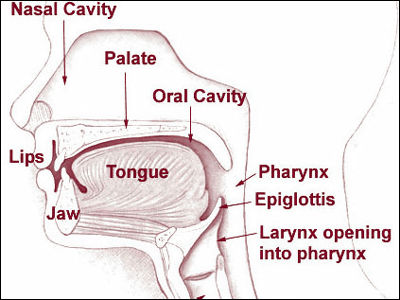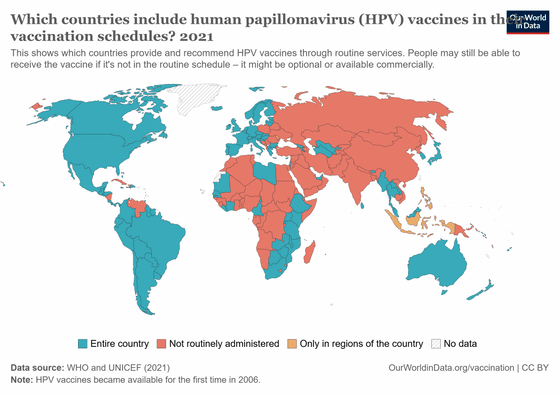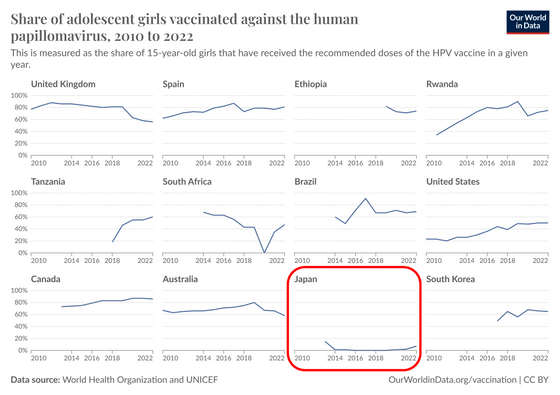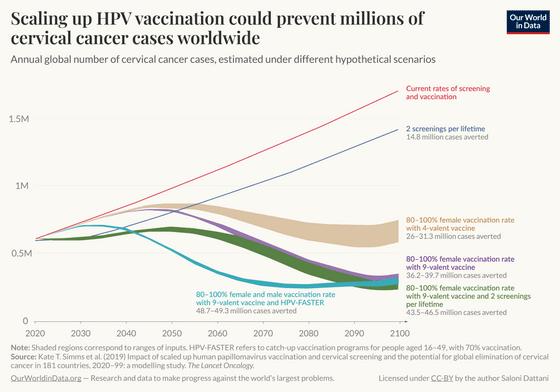Data showing how effective the HPV vaccine is in preventing cervical cancer is released, and Japanese media is also criticized

Worldwide, more than 500,000 women develop cervical cancer each year, and 300,000 women die from it. Our World in Data, a website that provides scientific data on global issues, has compiled and published easy-to-understand graphs and maps on the effectiveness of vaccines to prevent human papillomavirus (HPV), the main cause of cervical cancer, as well as the current state of global efforts to prevent the disease.
HPV vaccination: How the world can eliminate cervical cancer - Our World in Data
HPV is a very common virus that many people will be infected with at least once in their lifetime, but when it spreads through physical contact such as sexual intercourse, it can infect somatic cells such as the cervix, vagina, penis, and mouth.
When a person is infected with HPV, the viral genes are incorporated into the DNA of the cells, inhibiting the protein synthesis system that protects the body from uncontrolled cell growth, ultimately increasing the risk of developing cancer.
HPV is known to cause oropharyngeal cancer, which is more prevalent in men, and is therefore a virus that is relevant to men as well. However, for women in particular, it is a serious problem, as more than 90% of cervical cancers are caused by HPV, which can lead to loss of fertility and even death.
What you need to know about sexually transmitted HPV (human papillomavirus), which is also the cause of throat and tongue cancer - GIGAZINE

The HPV vaccine has been shown to reduce the incidence of cervical cancer by 90% , and some countries around the world are on the verge of eradicating it through large-scale vaccination programs.
For example, it has been reported that young people in the UK who received the vaccine while at school have a dramatically lower incidence of cervical cancer than other generations. This is shown in the graph below, where the youngest group (red line), who had a vaccination rate of 89%, had a cervical cancer incidence rate (vertical axis) that was about 87% lower than the oldest group (blue line).

On the other hand, there are many countries where access to the HPV vaccine is insufficient. Below is the new incidence rate of cervical cancer by country in 2022. In Africa and South America, the incidence rate per 100,000 women has been shown to be high.

Furthermore, if we look at a graph of the incidence rates of cervical cancer in the 19 major countries that make up the G20, we can see that unfortunately, Japan has a higher number of women suffering from cervical cancer than Europe and the United States, and is on par with South America.

Our World in Data points out that cervical cancer remains so prevalent in part because women living in poor countries lack access to early screening, and in part because of low rates of HPV vaccination.
The chart below shows whether routine HPV vaccination is offered nationwide (turquoise), not available (red), or only in some areas (orange). It shows that vaccine introduction has not progressed very far in Africa and Asia.

Although Japan is a country that administers HPV vaccines on a regular basis, the percentage of women who have received the vaccine by the age of 15, the age at which HPV vaccination is particularly recommended, is 7% in Japan, far behind the United States (50%) and South Korea (65%).

Our World in Data cites two examples of countries with problems in vaccination. One is China, where the HPV vaccine is becoming available in some cities and regions, but is not available nationwide. As a result, the national vaccination rate in China is very low, and it has been
Another example is Japan, where 'HPV vaccinations were suspended in Japan from 2013 to 2021 due to inaccurate media reports linking the vaccine to pregnancy complications,' Our World in Data noted.
A large-scale study examining the relationship between the 9-valent HPV vaccine and side effects such as thrombosis found no association between vaccination and the risks. Following this safety verification, HPV vaccine administration will resume in Japan in 2022.
A simulation conducted by Kate T. Sims, Honorary Senior Research Fellow at the School of Public Health at the University of Sydney, and her colleagues found that if vaccination rates were achieved at 80-100% among young men and women, and booster vaccinations were administered to adults, approximately 50 million cases of cervical cancer could be prevented by 2100.

Our World in Data said, 'Countries where HPV vaccination is widespread and cervical cancer screening is routine have already seen dramatic declines in cancer incidence, demonstrating that HPV-related cervical cancer can be effectively eliminated. However, many countries are lagging behind, some with barriers to accessing the vaccine and others with low uptake rates due to widespread misunderstandings. The HPV vaccine represents a rare opportunity to effectively eliminate a common type of cancer, and by investing in vaccination and testing, the world can save hundreds of thousands of lives each year, prevent avoidable tragedies, and make cervical cancer a disease of the past.'
Related Posts:
in Science, Posted by log1l_ks






